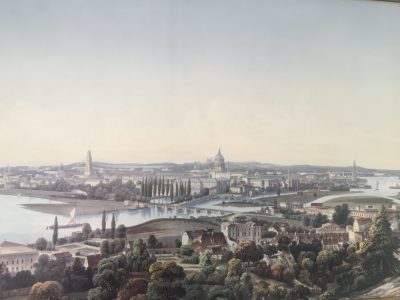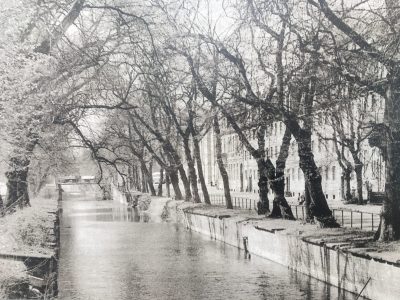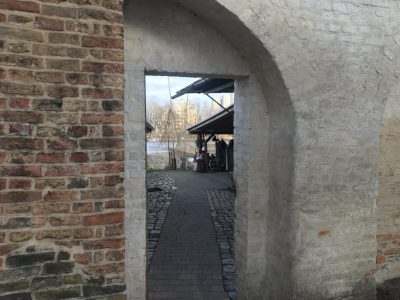Where Potsdam once began – the church and the castle, the fortress wall and the channel, fish and fishermen.
Since the 6th century the Slavic tribes settled down at swampy area where Potsdam is located today. Surely they were attracted not with the beauty of the landscape bringing over the tourists nowadays but with plenty of fish in the water of Havel. Of course they also raised the cattle and сultivated the land as the excavations show – interestingly, not at the “Old market” square, the historical center of today, but some 1,5 km to the north-east. This area was marked by the “Heilig-Geist-Kirche”, or Holy Spirit church, one of the three main churches you can see at the panoramic pictures of Potsdam dated by 18th and 19th centuries. Unfortunately the church burnt down in 1945 and the socialist German government was definitely against reconstruction. So only in 1997 a building appeared here resembling of the former church due to its shape and height. Built according to the project of the Italian architect Romano Burelli this tower is to remind about the place where once the church stood, now in use as a nursing home. The сertain “must do” if you happen to be close to it: take the elevator to the upper floor to enjoy a stunning view of surrounding lakes and parks. With some luck you can also take a benefit of the Сafe there on Saturdays and Sundays although it is often closed for one reason or another. Get the keys for 2 Euros to open the door to the observation deck above at the concierge at the entrance of the building.
Back to Slavic tribes, they were concurred in the year of 928 by Henry I Duke of Saxony and had to pay tax. Moreover, they were supposed to convert to Christianity, the idea they did not like at all. As a result the invaders were kicked out and the population returned to the life it used to lead at the bank of Havel surrounded with woods and swamps from all sides, now also with a newly build massive castle. That was the time Postdam was first mentioned in the chronicles, as a present of the young king Otto III to his aunt, the abbes in Quidlingurg short of land with her abbey. In the gift certificate the place „Potstupimi“ is mentioned meaning “under the oak trees” translated from old Slavonic.
There is no lack of oak trees in Potsdam so we suppose it is a good idea. Besides, a legend exists, rather sad as usual, about a charming girl who fell in love with prince on his visit. As the prince had to go back he promised to return as soon as he can and the girl promised to wait for him under the oak trees. At home however the prince was thrown to jail as a result of an overturn which he managed somehow to escape heading at once for the oak trees. But only a corpse of the frozen girl was waiting for him there. The winters were much more severe those days.
Back to the abbes of Quidlinburg, in spite of the lack of land she was not very much inspired with the gift which of course was good for Slavs. Only as Albrecht the Bear, later the first margrave of Brandenburg came here, the Slavs had to move westwards to the place behind the “New Market” square leaving the land to Germans. Who started to build the castle of their own at the place where the center of Potsdam is located today.
But we mentioned the fortress wall. Yes, there was one in Potsdam, and the remnants of it can be seen just at the place where the Slavs lived. But there is something unusual about it. Namely, it was built only at 18th century as Potsdam was already a residential city of the electors and later the kings and was not to protect the city from the enemies outside. No, the idea was to keep the newly born Prussian army (eager to run away because of miserable сonditions) inside it. Living at the private homes without common language and cultural values with locals, poor salary and сruel drill – who did not want to escape? At the very first year of Prussian army formed by „Soldier King” some 3 thousand people disappeared, a huge figure for these times! So the wall was to prevent them, acting as a duty collection besides.
Different to another piece of the wall left at Luisenplatz where the restaurant “The old city watchman” ((Alter Stadwächter) is situated there is no place to eat here, at the banks of Havel. We do not know why it is so. But the locals made the best of the neighbourhood with the wall, putting armchairs and tables with candles beside it to relax in the warm summer nights. And the fish is still nearby as it was at Slavonic times: every morning fishermen start from here with their boats, selling it still alive later. Zander and eel, catfish and hake, perch and carp, also sturgeons are sometimes to be seen here they say. The fishery Weber is located just behind the small door in the fortress wall, at the “Big Fisher Street” (Große Fischerstraße). If you like they will сut the catch for you with the accompaniment of seagulls screaming.
And there is another interesting point near the northern end of the wall! Here the city channel began used to drain the swampy terrain of Potsdam already at the 17th century. Crossing the whole downtown from back then it joined Havel River at 2 end points. The water full of pleasure and freight boats it was nicely decorated with the most beautiful houses standing at its banks where also the fish trade took place. Although the owners of the houses were bothered a bit with the smell coming from the channel (which was not surprising, keeping also in mind that there was no sewerage in Potsdam until 20th century), they somehow got used to it by and by.
As the war was over the socialist government considered it better to engulf the channel as an excess bourgeois luxury, making a parking over it (however, digging a trench parallel to it as no matter socialism or capitalism, the ground remained swampy). And after Germany became united the enthusiasts supported also by the present Potsdam government started to dig out the channel again. You can already see one of the restored fragments together with pictures of the prewar times just at the place where Potsdam once began.











